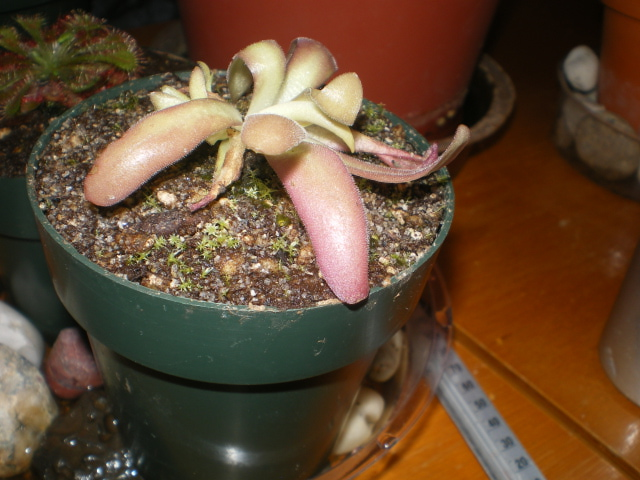Question Pink Ping
Pink Ping
QUESTION: Hello SNW,
I recently purchased a Pinguicula x 'Aphrodite' from you. It grows with my healthy sundews under a 28 Watt Cool White Flourescent Lamp. It used to be pink, as shown here. Now it's all green. Is that bad?
Also, I have a Poi Dog Nepenthes I ordered from you, and I think it has Highland ancestry. I'm worried it might be too highland for it's growing area, (65-70 degrees F), so what are symptoms of being too warm to look out for, just in case?
Thanks a lot,
John
ANSWER: Hi John,
Aphrodite can vary between light green to pink. In our greenhouse they were under quite bright conditions. As long as the leaves are well developed and sticky, you're fine. We have a very large one in our house that sits in a South Window that is all green, and it's beautiful. It will get tinges on pink in the summer when we have more sun.
65-70 F is just fine for your Poi Dog. Most of those have mixed ancestry including lowlander, so they actually do better when it's a bit warmer. Daytime near 80 with night cool-downs makes they very happy!
Good Growing!
Jeff Dallas
Sarracenia Northwest
http://www.growcarnivorousplants.com
---------- FOLLOW-UP ----------
QUESTION: I would still like to know the symptoms for a highland Nepenthes being kept too warm, in case I ever (unbeknownst to me) got a highlander. What are the symptoms?
AnswerHi John,
It's nothing too dramatic. The plant just slows down in growth; pitcher production stops. Leaves get smaller. Over the course of a month or two nothing changes, then the plant just dies.
What's more helpful to do is educate yourself on which Nepenthes are true highlanders in needing the night cool-down. Examples that come to mind immediately are N. villosa, N. spectablis, N. hamata, N. lowii, N. rajah. Plants that are frequently labeled as highland are actually intermediate in how they behave such as N. sanguinea, N. ventricosa, and many N. maxima forms. Household temperatures are perfect for them. A good example of some plants labeled as lowland, but respond well to house temperatures would be N. truncata lowland form, and some N. mirablis forms. Hybrids are very plant by plant.
Welcome to the world of Nepenthes. Just like orchids I wish there was an all-encompassing guide to this, but it's really a matter of getting to know certain plants, and which ones will work for your particular environment. Getting involved on cp forums is very helpful for this. That way you can see what has work for folks in particular growing environments.
Good Growing!
Jeff Dallas
Sarracenia Northwest
http://www.growcarnivorousplants.com






